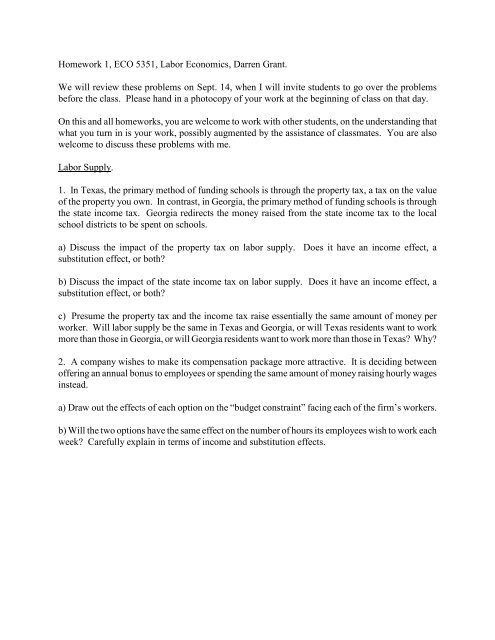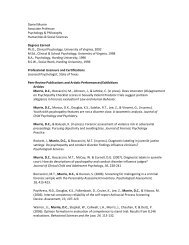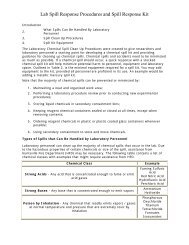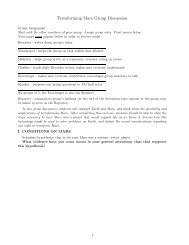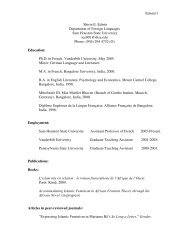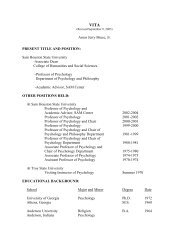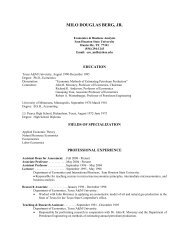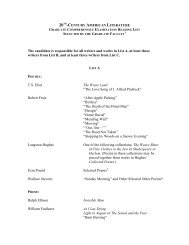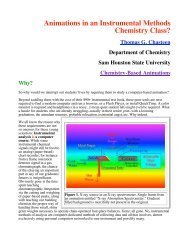Homework 1, ECO 5351, Labor Economics, Darren Grant. We will ...
Homework 1, ECO 5351, Labor Economics, Darren Grant. We will ...
Homework 1, ECO 5351, Labor Economics, Darren Grant. We will ...
Create successful ePaper yourself
Turn your PDF publications into a flip-book with our unique Google optimized e-Paper software.
<strong>Homework</strong> 1, <strong>ECO</strong> <strong>5351</strong>, <strong>Labor</strong> <strong>Economics</strong>, <strong>Darren</strong> <strong>Grant</strong>.<br />
<strong>We</strong> <strong>will</strong> review these problems on Sept. 14, when I <strong>will</strong> invite students to go over the problems<br />
before the class. Please hand in a photocopy of your work at the beginning of class on that day.<br />
On this and all homeworks, you are welcome to work with other students, on the understanding that<br />
what you turn in is your work, possibly augmented by the assistance of classmates. You are also<br />
welcome to discuss these problems with me.<br />
<strong>Labor</strong> Supply.<br />
1. In Texas, the primary method of funding schools is through the property tax, a tax on the value<br />
of the property you own. In contrast, in Georgia, the primary method of funding schools is through<br />
the state income tax. Georgia redirects the money raised from the state income tax to the local<br />
school districts to be spent on schools.<br />
a) Discuss the impact of the property tax on labor supply. Does it have an income effect, a<br />
substitution effect, or both?<br />
b) Discuss the impact of the state income tax on labor supply. Does it have an income effect, a<br />
substitution effect, or both?<br />
c) Presume the property tax and the income tax raise essentially the same amount of money per<br />
worker. Will labor supply be the same in Texas and Georgia, or <strong>will</strong> Texas residents want to work<br />
more than those in Georgia, or <strong>will</strong> Georgia residents want to work more than those in Texas? Why?<br />
2. A company wishes to make its compensation package more attractive. It is deciding between<br />
offering an annual bonus to employees or spending the same amount of money raising hourly wages<br />
instead.<br />
a) Draw out the effects of each option on the “budget constraint” facing each of the firm’s workers.<br />
b) Will the two options have the same effect on the number of hours its employees wish to work each<br />
week? Carefully explain in terms of income and substitution effects.
<strong>Labor</strong> Demand.<br />
3. Around 1820, with the invention of improvements in the milling of cotton, such as the cotton gin,<br />
cotton became much cheaper to grow and "clean" and cotton production exploded. In 1950, with<br />
the invention of the mechanical cotton harvester, fewer farm laborers (or sharecroppers) were needed<br />
to harvest the cotton.<br />
a) Consider the effect of the cotton gin on the demand for cotton farm laborers. Does demand go<br />
up because of a scale effect, a substitution effect, or both?<br />
b) Consider the effect of the mechanical harvester on the demand for cotton farm laborers. Does<br />
demand go down because of a scale effect, a substitution effect, or both?<br />
4. The institution of Blue Laws in many Southern states disallowed work on Sunday. Imagine a<br />
manufacturing industry that operated seven days a week prior to the Blue Laws, but now each firm<br />
must close on Sundays. In the short run–in the period immediately after the Blue Law is<br />
passed–there is no opportunity to substitute capital for labor or vice versa.<br />
a) Law of Diminishing Returns. If the firms in the industry each have a standard production process,<br />
what <strong>will</strong> they do in the short run? Choose one option below and explain, using the Law of<br />
Diminishing Returns in your answer.<br />
1) employ 1/7th fewer workers, since they are closed 1/7th of the time<br />
2) employ fewer workers, but not 1/7th fewer<br />
3) employ the same number of workers as before<br />
5. Blue Laws also create a disincentive to use capital, because the capital must sit idle on Sunday<br />
when there is no one to operate it. In this sense, the Blue Laws can be considered a tax on capital.<br />
If you would like to use the capital every day but it must sit idle on Sunday, then it’s like a tax of<br />
16%. In the long run there is an opportunity to adjust the scale of the business enterprise and to<br />
substitute capital for labor or vice versa.<br />
a) Scale Effect. The idle capital <strong>will</strong> dampen profits in the industry. Describe the scale effect on<br />
employment that results in the long run, and indicate whether it has a positive or negative influence<br />
on labor demand in the industry.<br />
b) Substitution Effect. The Blue Laws have increased the effective price of capital, as noted above,<br />
and they have lowered the price of labor (presuming workers disliked working on Sunday). Describe<br />
the substitution effect on employment that results in the long run, and indicate whether it has a<br />
positive or negative influence on labor demand.
<strong>Homework</strong> 2, <strong>ECO</strong> <strong>5351</strong>, <strong>Labor</strong> <strong>Economics</strong>, <strong>Darren</strong> <strong>Grant</strong>.<br />
Supply /Demand Analysis.<br />
1. The child care industry is a highly competitive industry, and child care workers are hired in a<br />
highly competitive labor market. There is a sizable Child Care Tax Credit, which lowers the taxes<br />
of those parents who put their children in (paid) child care while they (the parents) work.<br />
a) Illustrate, on an S/D graph, the effect of the tax credit on the price and quantity of child care in<br />
the short run.<br />
b) Illustrate, on an S/D graph, the effect of the tax credit on wages and employment in the nursing<br />
market (many nurses require child care for their children while they are at work).<br />
c) Illustrate, on an S/D graph, how the tax credit affects wages and employment in the child care<br />
industry.<br />
d) An academic study (really) has found that the supply of child care workers is quite elastic. Redraw<br />
your graph in part c), showing this elasticity in your graph. In percentage terms, which changes<br />
more as a result of the tax credit: the wages of child care workers, or the total number of child care<br />
workers employed?<br />
2. An increase in income tax rates, as if the Bush tax cuts expire, can raise the wage costs of<br />
employers.<br />
a) Explain why, using a supply/demand graph.<br />
b) Describe the income and substitution effects of this income tax increase on labor supply. Must<br />
employers’ wage costs go up?<br />
c) Will the income effect be stronger if the tax increase is temporary or permanent? Explain.<br />
3. Explain, using Supply/Demand analysis, the effects of the following. For each, draw two graphs,<br />
one for the labor market (workers), and one for the output market (the product).<br />
a) A machine is developed that harvests tomatoes mechanically (on the market for laborers, and the<br />
tomato market).<br />
b) An economic contraction leads to a slowdown in housing construction (on the housing market,<br />
and the market for construction workers).<br />
c) Oil is discovered in tar sands in Alberta, Canada (on the market for workers in the oil industry,<br />
and the oil market).<br />
d) World War I kills a substantial fraction of the unskilled (primarily young) workers in the countries<br />
involved (on the market for low-skill labor, and for products made by low-skill labor).
Unemployment.<br />
4. If I was discussing “The Macroeconomics of SHSU,” I would define “output” as the amount of<br />
learning that takes place at the university and “unemployment” as the inability of a student to register<br />
for a class that he or she desires to take.<br />
a) In this context (Macro of SHSU), describe what structural unemployment would be, or give an<br />
example; then do the same for cyclical unemployment.<br />
b) How would a tuition increase affect the rate of unemployment?<br />
c) To make the analogy to the labor market concrete, in this example students are like ____, the<br />
university is like ______, and a tuition decrease is like ___. Fill in each blank with its labor market<br />
counterpart.<br />
Compensating Wage Differentials.<br />
5. (Ehrenberg and Smith, modified) Some employers offer jobs for which overtime is mandatory.<br />
Others offer jobs for which overtime hours are usually available to workers if they wish to work<br />
them. Still other employers offer jobs for which overtime hours are not commonly worked. By law,<br />
overtime pay for hourly workers is 50% greater than regular pay. Suppose that a careful study of<br />
wages finds that, all else equal, jobs for which overtime hours are commonly available pay lower<br />
wages than jobs for which overtime is not usually worked. (The term “wage” refers to the normal<br />
wage, not the overtime wage.) Furthermore, the study finds that jobs for which overtime is not<br />
usually worked pay less than jobs in which overtime is mandatory.<br />
a) What do the results of this study tell us about worker attitudes regarding overtime? Why?<br />
b) What kinds of workers would be sorted into each kind of job? Why?<br />
c) Illustrate the effects of these overtime provisions on wages using three supply/demand graphs.
<strong>Homework</strong> 3, <strong>ECO</strong> <strong>5351</strong>, <strong>Darren</strong> <strong>Grant</strong>.<br />
Schooling and Human Capital<br />
1. Below, from an academic study, is a table of the returns to education of white and black males<br />
in South Africa, showing the wage premia for being in the schooling category indicated vs. the next<br />
worse (less schooling) category. White males have many more years of schooling, on average, than<br />
do black males.<br />
a) The numbers in the table are much smaller than theory suggests they should be, don’t you think?<br />
b) Which of the following explanations are the data most consistent with? Why?<br />
1) Discrimination forces blacks into low wage jobs; that is, firms are reluctant to<br />
employ high skill blacks.<br />
2) Blacks lack the resources needed to obtain more schooling.<br />
c) Read the accompanying article on education in South Africa. Is the article’s thesis consistent with<br />
your conclusion in part b)?<br />
Blacks<br />
Whites<br />
Primary (Grammar School) 10% 0%<br />
Secondary (High School) 15% 10%<br />
Higher Education (4 years) 30% 10%<br />
2. The labor market in Japan is different than that in the United States in several different ways.<br />
a) One difference is that, in Japan, entry into college is (essentially) limited to those who can pass<br />
certain standardized tests. In the United States entry is not so limited. Illustrate the effect of the<br />
college entry limitations on the rate of return to schooling in Japan, using an appropriate<br />
supply/demand graph.<br />
b) A second difference is that in Japan there is more protectionism, and hence less international<br />
trade. How does this affect the rate of return to schooling? Discuss briefly and illustrate on an<br />
appropriate supply/demand graph.<br />
Human Capital and OJT<br />
3. (Milgrom and Roberts) Actuaries perform the crucial task of estimating the time paths and<br />
probability distributions of costs and revenues for different insurance contracts. Becoming an<br />
actuary takes several years, and involves passing a series of rigorous examinations given either by<br />
the Society of Actuaries (http://www.soa.org/) or by the Casualty Actuarial Society
(http://www.casact.org/). Usually the individual works for an insurance company while studying for<br />
the exams, and the company gives the individual time off to study for the exams. Passing an exam<br />
usually results in a significant pay increase.<br />
a) Do actuaries have general or firm-specific human capital?<br />
b) Who “pays for” the worker’s time off to study for the exams? Choose one answer and explain.<br />
1) the worker does, by accepting a lower salary<br />
2) the firm does, to invest in the worker’s human capital<br />
c) Why does the individual get a pay increase after passing each exam? Why not evaluate the<br />
employee once per year, like many companies do?<br />
4. (Milgrom and Roberts, revised) Workers who are laid off from their jobs generally receive lower<br />
wages once they find new jobs (Fact 1). Moreover, the wage reduction appears to be persistent–for<br />
many years, wages are lower than they would have been had the worker keep his/her old job (Fact<br />
2). Moreover, the wage loss differs by the type of job–nurses and truckers, for example, have<br />
smaller wage declines than do automobile production workers (Fact 3). Explain these three facts<br />
using human capital theory.<br />
5. Below is drawn a graph of pay and<br />
productivity at <strong>We</strong>irdCo, a company with<br />
“innovative” pay practices. The vertical axis is<br />
in dollars, and the horizontal axis indicates<br />
years spent at this firm. The point indicates the<br />
value of the worker’s general human capital at<br />
the time they join the firm; this human capital<br />
never goes away. The downward sloping line<br />
is the worker’s pay. Each year you work at<br />
<strong>We</strong>irdCo, your salary goes down. Initially,<br />
assume all human capital accumulated at<br />
<strong>We</strong>irdCo is general.<br />
tenure<br />
a) If human capital acquisition follows theory, what would happen? Draw the path of human capital<br />
acquisition on the graph, beginning, of course, at the point provided.<br />
b) How long would an individual joining this firm remain before leaving? Identify clearly on the<br />
graph, and briefly explain below.<br />
c) Now let all human capital acquired at <strong>We</strong>irdCo be firm-specific. How long would an individual<br />
joining this firm remain before leaving? Identify clearly on the graph and briefly explain below.<br />
d) Under what circumstances would this pay policy be effective? Choose one answer and explain.<br />
1) none–this pay policy just makes no sense<br />
2) it is a standard example of “backloaded compensation” used to incentivize effort<br />
3) this is the way most internal labor markets pay people
<strong>Homework</strong> 4, <strong>ECO</strong> <strong>5351</strong>, <strong>Darren</strong> <strong>Grant</strong>.<br />
Theory of Incentives<br />
1. At most country fairs, you pay for the rides with tickets, and for the dart/water pistol/guess-myweight<br />
games with cash.<br />
a) Why is this?<br />
b) Who gets paid more, the ride operators or the game hucksters? Why?<br />
2. Incentive conflicts show up in the sports world, too. This question looks at three such ways.<br />
(You need not know much about professional sports to answer this question.)<br />
a) Off-season training requires a lot of time and effort, yet is vital for many sports, such as soccer<br />
and football, for conditioning and injury prevention. Using a supply/demand type graph for effort,<br />
identify the optimal level of off-season training. Then explain why an athlete on a long-term,<br />
guaranteed contract could choose a level of off-season training that differs from the optimum.<br />
b) The “horizons” problem appears in football too: playing harder helps your team win more, but<br />
also leads to more injuries. The “optimal” degree of effort properly balances the two, and this is<br />
what a player on a short-term contract <strong>will</strong> do. Explain why, and then explain why the team<br />
employing this player <strong>will</strong> not properly balance the two–that is, there is an incentive conflict.<br />
c) This conflict <strong>will</strong> be smaller when the player is on a long-term contract instead. Explain why.<br />
(It might be useful to know that NFL players on contract are typically paid while injured.)<br />
d) Basketball consists of a few fundamental skills, passing, dribbling, shooting, defense. Yet<br />
basketball teams don’t just pay their players per shot made, shot blocked, shooting percentage, etc.<br />
Give one good reason why this would be unwise (economically).<br />
3. (Brickley et al., adapted) The Roman Empire taxed many faraway provinces. Every few years,<br />
Rome would auction tax collection rights for the next several years to the highest bidder, who then<br />
set the tax rate for the province, collected the taxes, and kept what they collected. See<br />
http://www.unrv.com/economy/roman-taxes.php for more information if you are curious.<br />
a) Why might this be superior to just sending out soldiers to collect the taxes?<br />
b) Why might multi-year auctions be superior to annual auctions? (That is, the Empire collects<br />
more revenue from multi-year auctions than a series of annual auctions.) Describe how multi-year<br />
auctions help solve a horizons problem that would be associated with single-year auctions.
HRM Systems<br />
4. Read the accompanying article, “Pressure at Mortgage Firm Led to Mass Approval of Bad<br />
Loans,” published at the beginning of the subprime crisis, and then answer the following questions.<br />
a) There are three parties here: employees, managers, and shareholders. Multiple incentive conflicts<br />
between these parties are discussed in this article. Identify and describe two of these conflicts.<br />
b) The horizon problem is particularly acute here. Discuss how it applies.<br />
c) From the information in the article, identify the way decision rights, evaluation, and incentives<br />
are supposed to work for the underwriters, such as Ms. Hardiman, who approve loans but do not<br />
“sell” them, i.e., meet with customers. In what way did these not operate as they were supposed to?<br />
5. I have taken a few liberties with the facts in order to make this question more clear-cut. Two of<br />
our largest groups of Native Americans are the Apache, located primarily in reservations in Arizona,<br />
and the Sioux, located primarily in reservations in South Dakota.<br />
Prior to American settlement, the Apache subsisted on agriculture, raising sheep, and food-gathering.<br />
While land was plentiful, agricultural land, and the crops grown on it, were private property;<br />
nevertheless, chiefs could and did tax families and redistribute income (food) to the less fortunate,<br />
though complete income equality did not occur. Chiefs were also responsible for deciding how<br />
many animals (sheep) should be eaten in any given year. Chiefs were vested with a great deal of<br />
decision making power, and generally served for life.<br />
The Sioux, on the other hand, subsisted on buffalo. While buffalo were plentiful enough, they don’t<br />
stay in one place, so the band constantly migrated as it searched for food. Hunting buffalo is very<br />
difficult, dangerous work. Buffalo hunts are very much team efforts, and the food killed in the hunt<br />
is shared completely within the band. The Sioux were loosely organized, bands were much smaller,<br />
and band chiefs had limited power and primarily operated through persuasion, and served at the<br />
pleasure of the band. Families can leave one band and join another if they wish.<br />
a) In the Apaches, band chiefs would redistribute income from the those with good harvests to those<br />
with worse harvests, but did not equalize income across families. Why is this the optimal system<br />
from the perspective of the “firm” or tribe? Discuss in terms of incentive pay.<br />
b) From an economic perspective, giving the Apache chief a life reign may be advantageous because<br />
it can reduce incentive conflicts. Discuss.<br />
c) The Sioux system has the following features: 1) Small bands, 2) free movement from one band<br />
to another, and 3) limited power on the part of the chief. Describe how these features work together<br />
to help the bands operate most effectively.<br />
d) Explain how the organization of each tribe is shaped by the environmental conditions under<br />
which it operates. To do this, articulate the primary HRM objective of each tribe, relate it to the<br />
tribe’s environment, and then show how the tribe’s organization best achieves that objective.


